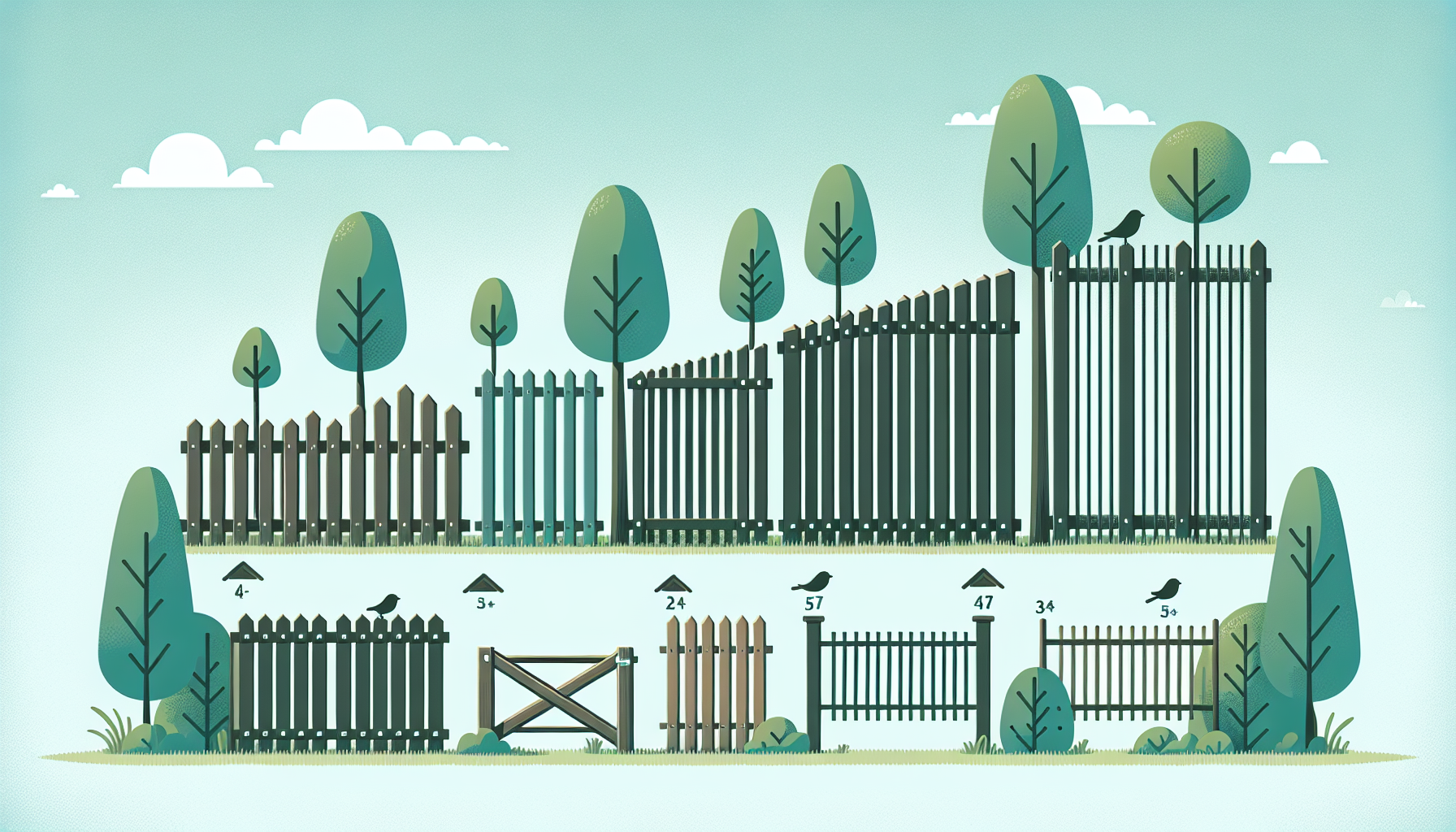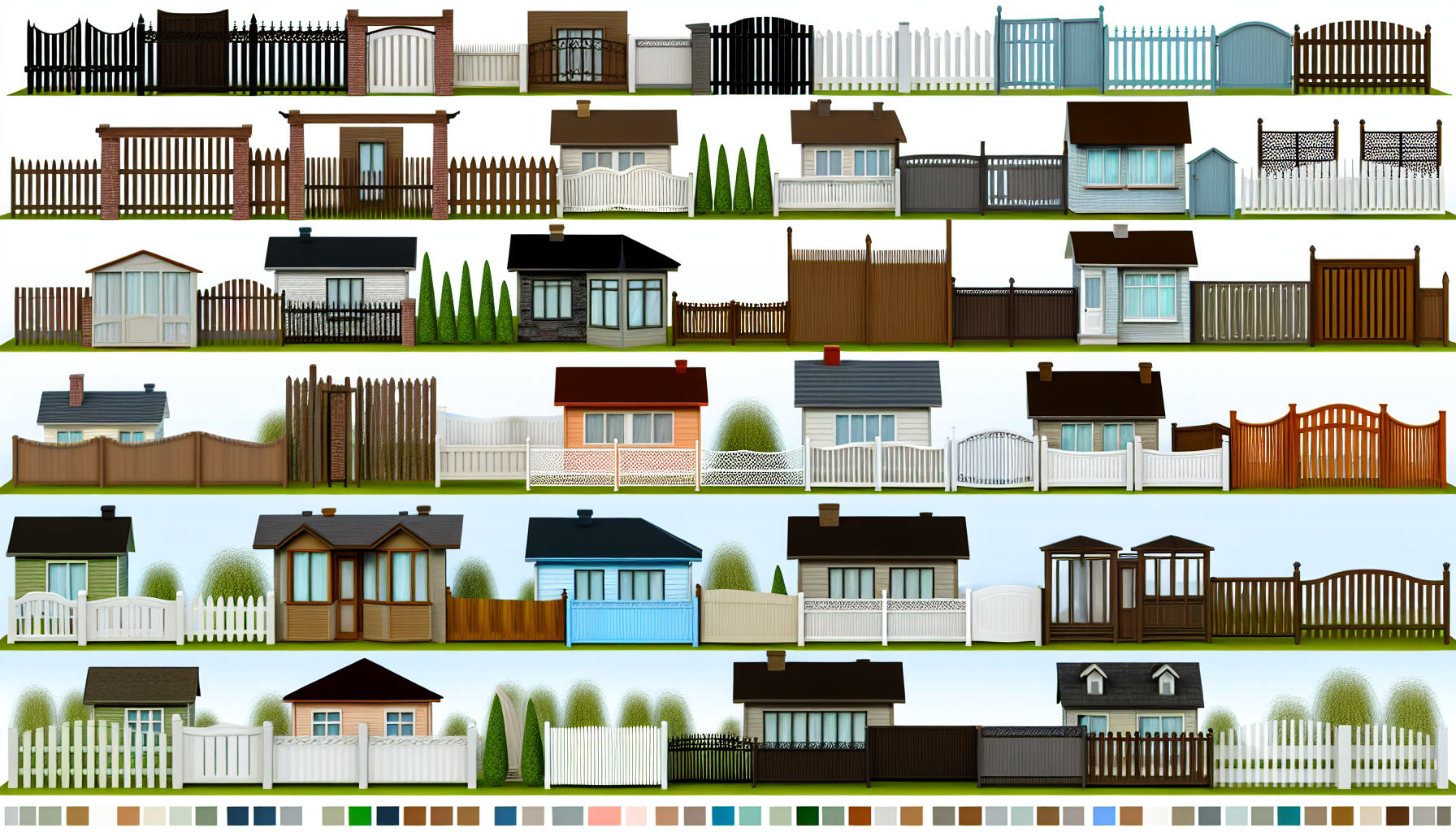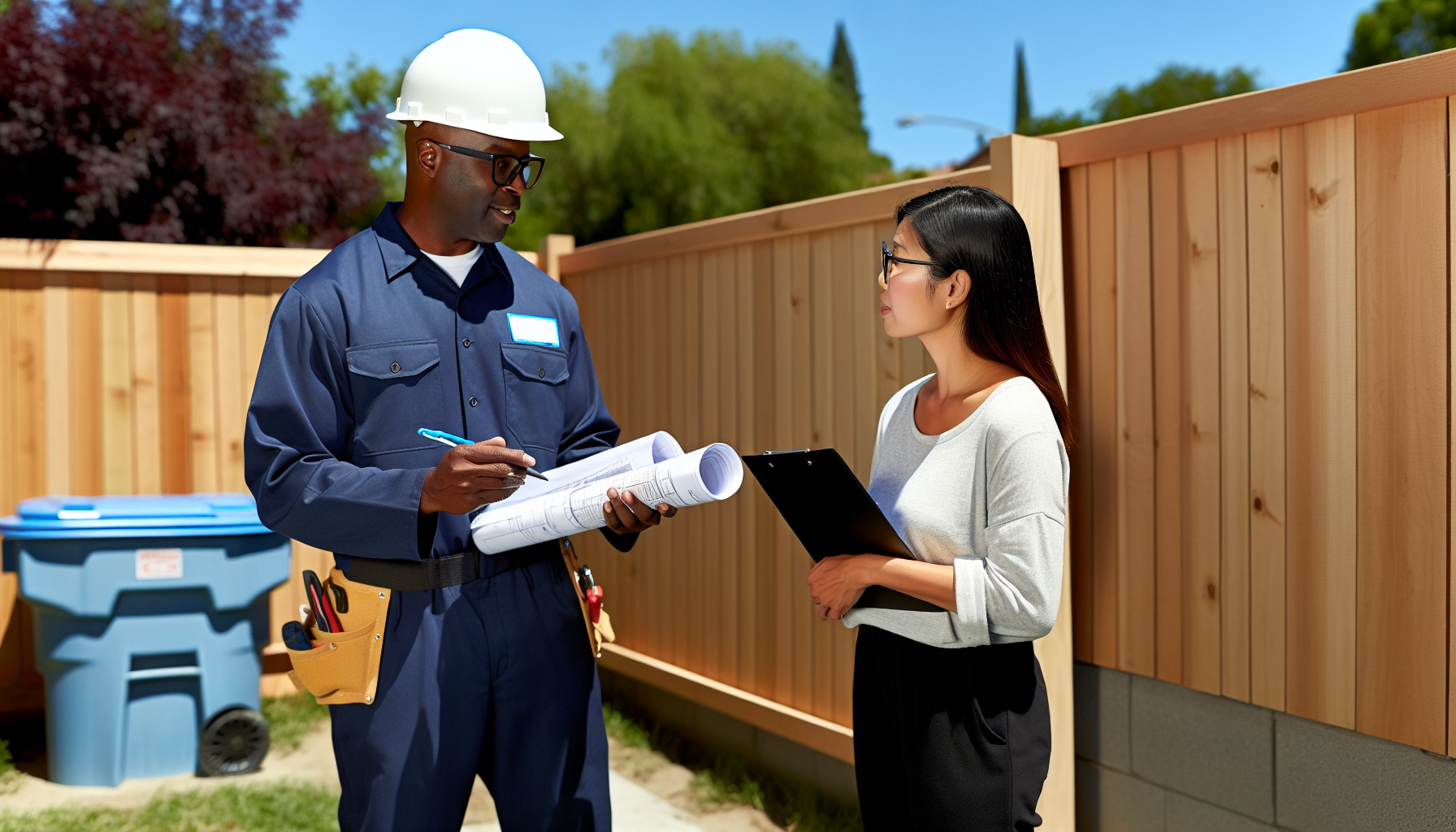Do I need a permit for a residential fence? This is one of the most common questions we get asked and chances are, you do. Skip the guesswork and dive into our practical guide on fence permits for your home. You’ll discover exactly when a permit is needed, how to apply, and what to expect from your local zoning board. We’ve streamlined the essentials so you can start your fencing project with confidence.
Key Takeaways
- Most fences require a permit, which involve submitting a detailed plan and boundary survey to local zoning departments who inform on height restrictions and other regulations.
- Fence height is a critical factor in construction permit requirements. Generally, fences under 6 feet don’t need permits unless they include masonry over 6 feet or are in flood-prone areas.
- Compliance with local zoning ordinances, building codes, and homeowners’ association rules is essential to ensure the fence meets community standards, safety, and design regulations.
Navigating the Fence Permit Process
Building a fence may seem like a simple DIY task, but it’s actually a project that requires careful planning and consideration of several regulations. From fence height to fence placement, every detail counts and can make a difference in whether you need a permit or not.
The construction permit process for building a fence commences with contacting your local zoning department. They can furnish you with essential details about the permits needed for your fence construction. Still unsure what to include in your fence permit application? Along with the application form, you may need to provide:
- A detailed site plan showing the proposed fence’s location
- A boundary survey – this may not be necessary of there is an existing fence that you are replacing.
- Other specifics, such as fence height and the materials you’ll be using.
Typically, processing a fence permit application takes about three days. But remember, rules and timelines can vary from one locality to another, so it’s crucial to gather all the accurate information from your local zoning department.
Starting with the Local Zoning Department
The local zoning department plays a significant role in the fence permit process. They provide the necessary construction permits and guide you on the height restrictions and other regulations related to your area.
To get started, you’ll need to fill out an application and provide a scaled plan of your fence. Familiarizing yourself with the local zoning laws and regulations for fence construction is paramount.
Getting in touch with them can be as easy as making a phone call. They often have dedicated customer service numbers and offer comprehensive guidance, including help with fence installation near environmentally critical areas such as steep slopes.
However, it’s important to follow the rules. Failing to comply with the fence regulations set by the local zoning department can lead to serious consequences. You might end up facing fines, being required to take down the fence, or even getting into legal trouble. It’s better to be safe than sorry!
Which Local Zoning Department do I Contact for a Fence Permit?
It depends on the location. In general its’ the city where the home is located that runs the permitting process, so your best bet is to start there. Find out what their regulations are and if you need to reach out to the state or county.
A county permit is generally only required if the home is in an unincorporated area.
States tend to have limited regulation regarding fences. They most often stick to boundary regulations. However there are exceptions for new construction. For example: Washington State does not have any stated limits on height, but it does require a permit if the fence is over 6 feet tall – WAC 51-16-080.
Helpful Hint: Check with your local fence contractor and ask them if they will help with the permitting process. Most will obtain the permit for you and wrap the fee into your estimate.
Understanding the Permit Application
When applying for a fence permit, you need to be prepared with all the necessary documentation. This includes:
- An application form
- A scaled boundary survey done by a licensed surveyor
- Details about where the fence will be in relation to nearby right of way, open spaces, parks, or trails
If you’re planning to install electric fences, make sure to mention it in your application.
The cost of the fence permit application can vary, with fees ranging anywhere between $50 to $300. The processing time also varies, typically taking about one to two weeks.
For a successful application, you need to submit an application form and a scaled site plan detailing the location and dimensions of the proposed fence, along with the necessary application fee. Accurate completion of the application is vital to prevent delays or complications.
The Role of Fence Height in Permit Requirements
Your fence’s height significantly influences whether a permit is needed. Here are some general guidelines:
- If you’re planning on a fence that’s 6 feet or less, you generally won’t need a permit.
- However, if there’s masonry or concrete over 6 feet, or if it’s in a flood-prone area, a permit will be necessary.
- A taller fence will almost certainly require construction permit.
- The rules can vary by neighborhood, so it’s best to double-check local regulations.
A taller fence might require more permits due to concerns about visibility and safety. For instance, on corner lots, there are specific height restrictions to ensure clear sight lines for traffic, pedestrians, and neighbors. This might mean needing a permit even if the fence is under 6 feet tall.
Depending on the city there may be certain restrictions regarding line of site for entry ways into community developments. Condominium complexes sometimes run into this. While the complex may be private property, if there is a road, the city may require a height restriction at each entry point.
Different areas often have their own rules for fence heights. For example, in Seattle, you can usually build an 8-foot fence without a permit, unless certain conditions apply. In Spokane County, the front and flanking street yards have a 36-inch limit for fences that could block sight, while backyard fences are typically restricted to six feet and front yard fences to four feet.
Design and Material Considerations for Fence Permits
The design and material of your fence can significantly impact the permit process. Generally, you can use materials like:
- wood
- chain-link
- wrought iron
- cedar wood
- decorative metal
for residential fences. Nevertheless, consulting the local zoning ordinances and height restrictions for particular regulations is advisable.
Homeowners’ associations often have their own rules concerning fence materials and designs. These rules are designed to maintain the aesthetic uniformity of the neighborhood and might affect the materials and designs you can use for your fence.
The material and design of a fence can also impact how the property is viewed by the community. Permits are typically needed to ensure the fence meets specific standards and rules. Choosing a material that aligns with safety standards and local codes is of utmost importance.
Compliance with Building Codes and Safety Standards
Compliance with building codes and safety standards forms an integral part of the permit process. You can ensure this compliance by reaching out to your local zoning department and obtaining the necessary permits and inspections.
Non-compliance can lead to serious consequences. If you don’t follow the building codes and safety standards, you could end up:
- having to take down the fence
- getting fined
- facing delays
- dealing with higher costs
- having to demolish and start over
Compliance extends beyond mere adherence to rules. It’s also about maintaining safety, preserving property values, and ensuring that your fence serves its purpose without causing any problems. So, always make sure to comply with all building codes and safety standards.
The Impact of Homeowners Association Rules on Fence Projects
The rules set by homeowners associations can substantially influence fence projects. They often have guidelines and restrictions on fencing materials, styles, and overall designs, which can affect how your fence should be constructed.
Homeowners’ associations often require a minimum front yard fence height of six feet and a maximum width of individual slats of nine inches. These rules are designed to maintain the aesthetic uniformity of the neighborhood, taking into account the overall yard fence height.
The approval process for fence projects within a homeowners association can take anywhere from one to six weeks, depending on the complexity of the project and the size of the HOA. It’s important to provide detailed plans, drawings, or photos of the proposed fence, backed up with clear documentation, to speed up the process.
Coordinating with Neighbors: Good Fences Make Good Neighbors
Concerted effort with neighbors is a crucial aspect of fence installation. In fact, you might even need to share the cost and maintenance responsibilities of the fence with your neighbor.
Prior to fence installation, engaging your neighbors in a conversation about your plans can mitigate potential confusion about property boundaries and fence placement. A friendly chat can go a long way in maintaining good relationships with your neighbors.
Common issues neighbors face regarding fencing include disputes over property lines or unauthorized use of property. Clear communication, establishing boundaries, and working together to solve problems can prevent these issues.
Special Zones and Environmental Considerations
Fence projects in designated zones and environmentally critical areas might call for extra considerations. For instance, in historical districts, the rules for putting up fences can be quite strict, and you may need to consult with the local historic preservation office or zoning department.
Environmental restrictions can impact fence installations too. Local regulations might consider how the fence could affect the environment, like disturbing habitats, causing soil erosion, or disrupting wildlife.
In wildlife protection zones, you’ll usually need a construction subject-to-field-inspection permit for fences over a certain height or those near sensitive areas like steep slopes or water bodies. The rules might differ based on the specific location, so it’s important to check with your local authorities.
How Fence Contractors Can Simplify the Permitting Process
Engaging the services of a fence contractor can considerably streamline the permitting process for your retaining wall. They have a deep understanding of local regulations and can ensure your fence complies with all necessary permitting.
Fence contractors can also expedite the permitting process by working closely with the township to get your permit processed and ensuring all the necessary details are in place.
Fence contractors can provide assistance with permit applications, delineate property boundaries and neighbor responsibilities, and offer guidance on legal mandates and permit procedures. Their expertise can save you time and help you avoid potential pitfalls.
Obtaining the Necessary Fence Permits in the Greater Seattle Area
For homeowners in the Greater Seattle area we’ve put together a helpful list of links to city permitting offices. You’ll find applications, hours of operation, email addresses, phone numbers, and links to any requirements.
- Seattle: Department of Construction and Inspections (SDCI)
- City of Snohomish Permit Center
- Bothell Permit Center
- Everett Permit Services
- Lynnwood Development & Business Services
- Kirkland: Development Services Center
- Bellevue Permit Center
- Redmond: Department of planning and Community Development
- Mill Creek Permit Counter
- Edmonds Planning and Development Department
- Mukilteo Permit Center
- Lake Forest Park Permit Center
- Marysville Permit Services
- Granite Falls Building Services
- Monroe Permitting Department
Additional Washington State Resources
- Washington State property fence laws
- King County fence building permit relations
- Snohomish County planning and development
Summary
Navigating the permit process for a new fence involves understanding various local, state, and homeowners’ association rules. From fence height and design to material considerations and building codes, every detail counts. Special zones and environmental considerations add a layer of complexity to the process. But with proper planning, understanding of the rules, and open communication with your neighbors, you can successfully navigate through this maze with ease.
Hiring a fence contractor can significantly simplify the permitting process. They’re well-versed in local regulations and can ensure your fence complies with all necessary permits, ultimately saving you time and potential headaches.
Remember, the goal is not just to build a fence but to build a fence that complies with all the regulations, serves its purpose, and enhances your property’s aesthetics. So, the next time you think about installing a fence, don’t just pick up that shovel. Do your research, understand the rules, and plan accordingly.
Frequently Asked Questions
What is the fence law in Washington state?
In Washington state, a fence is considered lawful if it meets specific requirements outlined in Section 16.60. 010. This includes having at least four barbed, horizontal wires that are well-stretched and properly spaced, with the top wire at 48 inches and the others at 12, 22, and 32 inches.
Do you need a permit for a fence in Seattle?
In Seattle, you generally don’t need a permit for a fence that is 8 feet high or lower and doesn’t include masonry or concrete over 6 feet, unless it will be located in a flood-prone area. Always check with your local government for specific details!
What is the Good Neighbor fence Act?
In Washington state, the Good Neighbor Fence Act allows you to request your neighbor to share the costs of building a fence erected on the property line. This law prohibits constructing a fence to spite or annoy a neighbor.
What is the maximum height for a fence in King County?
You can build a fence up to 6 feet in height without a permit in unincorporated King County. However, fences over 6 feet in height require a permit and must meet the required setbacks for the zoning of the parcel.
What is the purpose of a fence permit?
A fence permit serves to ensure safety, building codes, aesthetics, property lines, and property values. Remember, obtaining a permit can help avoid potential issues in the long run.
Got questions about fence regulations? https://atomicfence.com/contact-us/! We’re here to guide you through the rules and help you make informed decisions for your fencing project.








